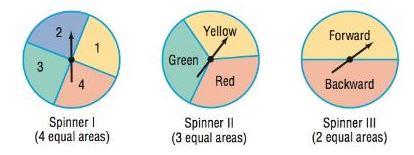
Concept explainers
In Problems 17-22, use the following spinners to construct a probability model for each experiment.

Spin spinner I, then spinner II. What is the probability of getting a 2 or a 4, followed by Red?
The probability of getting a 2 or a 4, followed by Red.
Answer to Problem 17AYU
Probability of getting 2 or a 4, followed by Red is .
Explanation of Solution
Given:
To spin spinner I, then spinner II.
Formula used:
If is the sample space of this experiment,
Calculation:
To get a 2 or a 4 followed by red.
The sample space is .
Each outcome is equally likely to occur; There are 12 outcomes.
Probability of getting 2 or a 4, followed by Red is given by ,
Chapter 13 Solutions
Precalculus Enhanced with Graphing Utilities
Additional Math Textbook Solutions
Introductory Statistics
Algebra and Trigonometry (6th Edition)
Basic Business Statistics, Student Value Edition
College Algebra (7th Edition)
College Algebra with Modeling & Visualization (5th Edition)
- 4. Suppose that the population of a certain collection of rare Brazilian ants is given by P(t)=(t+100) In(t+2), Where t represents the time in days. Find and interpret the rates of change of the population on the third day and on the tenth day.arrow_forwardFind all values of x for f (x)=(x²-4) 4 where the tangent line is horizontal. 5. Find the slope of the tangent line to the graph of f(x)=-√8x+1 at x=1. Write the equation of the tangent line.arrow_forward3. Find the derivative of each function. Label with appropriate derivative notation showing both dependent and independent variables. f(t)=4t(2t⭑+4)³ a. f(t)=4t (2t+4)³ (Answer must be factored.) b. y= 3 1 (2x³-4) 6arrow_forward
- 4.3 The Chain Rule 1. {Algebra review} Let f(x)=2x²-5 x and g(x)=6x+2. Find f[g(−5)]. 2. {Algebra review} Write h(x)=√√8x-3 as the composite of two functions f(x) and g(x). (There may be more than one way to do this.)arrow_forward4.4 Derivatives of Exponential Functions 1. Find derivatives of the functions defined as follows. a. g(t)=-3.4e b. y=e√x c. f(x)=(4x³+2)e³* d. y=- x²arrow_forward4.5 Derivatives of Logarithmic Functions 1. Find the derivative of each function. a) y=ln (-3x) b) f(u)=nu c) 9(x)=x-1 lnxarrow_forward
- 3. If the total revenue received from the sale of x items is given by R(x)=30ln (2x+1), While the total cost to produce x items is C(x)=✗, find the following. a) The marginal revenue b) The profit function P(x) (Hint: P(x)=R(x)-C(x)} c) The marginal profit when x=20 d) Interpret the results of part c).arrow_forward2. The sales of a new personal computer (in thousands) are given by S(t)=100-90€-04: Where t represents time in years. Find and interpret the rate of change of sales at each time. a) After 1 year b) After 5 years c) What is happening to the rate of change of sales as time goes on? d) Does the rate of change of sales ever equal zero?arrow_forward2. Find the equation of the line tangent to the graph of f(x)=ln(x²+5) at the point (-1, In 6). Do not approximate numbers.arrow_forward
 Calculus: Early TranscendentalsCalculusISBN:9781285741550Author:James StewartPublisher:Cengage Learning
Calculus: Early TranscendentalsCalculusISBN:9781285741550Author:James StewartPublisher:Cengage Learning Thomas' Calculus (14th Edition)CalculusISBN:9780134438986Author:Joel R. Hass, Christopher E. Heil, Maurice D. WeirPublisher:PEARSON
Thomas' Calculus (14th Edition)CalculusISBN:9780134438986Author:Joel R. Hass, Christopher E. Heil, Maurice D. WeirPublisher:PEARSON Calculus: Early Transcendentals (3rd Edition)CalculusISBN:9780134763644Author:William L. Briggs, Lyle Cochran, Bernard Gillett, Eric SchulzPublisher:PEARSON
Calculus: Early Transcendentals (3rd Edition)CalculusISBN:9780134763644Author:William L. Briggs, Lyle Cochran, Bernard Gillett, Eric SchulzPublisher:PEARSON Calculus: Early TranscendentalsCalculusISBN:9781319050740Author:Jon Rogawski, Colin Adams, Robert FranzosaPublisher:W. H. Freeman
Calculus: Early TranscendentalsCalculusISBN:9781319050740Author:Jon Rogawski, Colin Adams, Robert FranzosaPublisher:W. H. Freeman
 Calculus: Early Transcendental FunctionsCalculusISBN:9781337552516Author:Ron Larson, Bruce H. EdwardsPublisher:Cengage Learning
Calculus: Early Transcendental FunctionsCalculusISBN:9781337552516Author:Ron Larson, Bruce H. EdwardsPublisher:Cengage Learning





